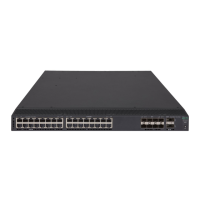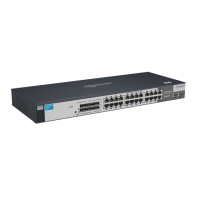34
− The configured domain ID is not available.
{ If all available domain IDs have been assigned, the principal switch notifies the downstream
switch that no domain ID can be assigned to it.
5. After the downstream switch receives the domain ID assignment notification from the principal
switch, it works according to the following rules:
{ The downstream switch isolates its upstream principal link and brings down the relevant
interface when one of the following conditions exists:
− The downstream switch has been configured with a static domain ID and the static domain
ID is different from the one assigned by the principal switch.
− The principal switch notifies the downstream switch that no domain ID can be assigned.
For more information about domain ID types, see "Configuring a domain ID for a switch."
{ If none of the preceding conditions exist, the downstream switch performs the following
operations:
− Accepts the domain ID assigned by the principal switch.
− Notifies its downstream switches to request domain IDs from the principal switch.
6. Steps 2 through 5 are repeated until all downstream switches have been assigned domain IDs.
NOTE:
During the process, if a switch receives a domain ID request on an E_Port, the switch records the E_Port.
The link relevant to this E_Port is called the downstream principal link.
FC address assignment
After a switch obtains a domain ID, it assigns FC addresses to N_Ports directly connected.
The Domain_ID field in the FC address is the domain ID of the switch, and it does not need assignment.
The switch assigns an FC address according to the following rules:
• If you bind the WWN of an N_Port to an FC address, the switch assigns the bound FC address to
the N_Port.
• If the N_Port itself has a desired FC address, the switch assigns the desired FC address, if available.
• The switch assigns the smallest available area ID and port ID to the N_Port when one of the
following conditions exists:
{ The N_Port itself does not have a desired FC address.
{ The desired FC address is unavailable.
Fabric building configuration task list
HP recommends that you use the dynamic mode for large networks to facilitate centralized management
and use the static mode for small networks to avoid network flapping.
